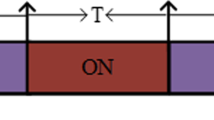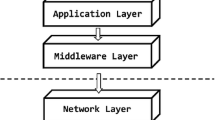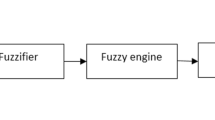Abstract
Energy is a critical factor to be considered in electrical and electronic systems. With the advent of technology, numerous techniques have been developed in communication systems to make the systems reliable, durable, and economic. In modern communication systems, the major requirements of an efficient radio model are to improve the delay, and throughput, reduce the energy consumption, and extend the network lifetime. So, there is a need to design a radio model to improve the quality of service (QoS) parameters. From the limitations identified in the wireless communication networks, the authors proposed an Enhanced Energy-Efficient Fuzzy-based Cognitive Radio scheme for Internet of things (IoT) networks. The proposed protocol is compared with the conventional method, Cognitive Radio-based Heterogeneous Wireless Sensor Area Network. The test-bed results show that the EEFCR protocol has achieved a significant gain on sum goodput versus a number of secondary radio users, average probability of bit error, computational time vs. sensor nodes, delay vs. sensing time. The computational time of the EEFCR protocol is shown to be 5% to 7% and 15% to 21% faster while comparing to CoRHAN and conventional methods. The EEFCR sensing time is reduced up to 80%. The average computational time for 500 nodes is reduced up to 40%. Also, 53% increment is achieved in spectrum utilization. The average bit error is reduced up to 5%.



























Similar content being viewed by others
References
Chithaluru P, Kumar S, Singh A, Benslimane A, Jangir SK (2021) An energy-efficient routing scheduling based on fuzzy ranking scheme for internet of things. IEEE Internet Things J 9(10):7251–7260
Chithaluru P, Al-Turjman F, Kumar M, Stephan T (2021) MTCEE-LLN: multilayer threshold cluster-based energy efficient low power and lossy networks for industrial internet of things. IEEE Internet Things J 9(7):4940–4948
Chithaluru P, Al-Turjman F, Stephan T, Kumar M, Mostarda L (2021) Energy-efficient blockchain implementation for cognitive wireless communication networks (CWCNs). Energy Rep 7:8277–8286
Chithaluru PK, Khan MS, Kumar M, Stephan T (2021) ETH-LEACH: an energy enhanced threshold routing protocol for WSNs. Int J Commun Syst 34(12):e4881
Chithaluru P, Tiwari R, Kumar K (2021) ARIOR: adaptive ranking-based improved opportunistic routing in wireless sensor networks. Wirel Personal Commun 116(1):153–176
Haykin S (2005) Cognitive radio: brain-empowered wireless communications. IEEE J Sel Areas Commun 23(2):201–220
Chithaluru P, Al-Turjman F, Kumar M, Stephan T (2020) I-AREOR: an energy-balanced clustering protocol for implementing green IoT in smart cities. Sustain Cities Soc 61:102254
Chithaluru P, Tiwari R, Kumar K (2019) AREOR-an adaptive ranking-based energy-efficient opportunistic routing scheme in Wireless Sensor Network. Comput Netw 162:106863
Akan OB, Karli OB, Ergul O (2009) Cognitive radio sensor networks. IEEE Netw 23(4):34–40
Mitola J, Maguire GQ (1999) Cognitive radio: making software radios more personal. IEEE Personal Commun 6(4):13–18
Carie A, Li M, Marapelli B, Reddy P, Dino H, Gohar M (2019) Cognitive radio assisted WSN with interference-aware AODV routing protocol. J Ambient Intell Humaniz Comput 10(10):4033–4042
Khan AA, Rehmani MH, Rachedi A (2017) Cognitive-radio-based internet of things: applications, architectures, spectrum-related functionalities, and future research directions. IEEE Wirel Commun 24(3):17–25
Zhang ZY, Jin CH, Liang XL, Chen Q, Peng LM (2006) Current-voltage characteristics and parameter retrieval of semiconducting nanowires. Appl Phys Lett 88(7):073102
Özgür Ü, Alivov Y, Morkoç H (2009) Microwave ferrites, part 1: fundamental properties. J Mater Sci Mater Electron 20(9):789–834
Isik MT, Akan OB (2009) A three-dimensional localization algorithm for underwater acoustic sensor networks. IEEE Trans Wirel Commun 8(9):4457–4463
Tachwali Y, Basma F, Refai HH (2010) Cognitive radio architecture for rapidly deployable heterogeneous wireless networks. IEEE Trans Consumer Electron 56(3):1426–1432
Bambos N, Chen SC, Pottie GJ (2000) Channel access algorithms with active link protection for wireless communication networks with power control. IEEE/ACM Trans Netw 8(5):583–597
Li S, Da Xu L, Wang X (2012) Compressed sensing signal and data acquisition in wireless sensor networks and internet of things. IEEE Trans Ind Inf 9(4):2177–2186
Xie L, Jia X, Zhou K (2012) QoS multicast routing in cognitive radio ad hoc networks. Int J Commun Syst 25(1):30–46
Yuan F, Zhan Y, Wang Y (2013) Data density correlation degree clustering method for data aggregation in WSN. IEEE Sens J 14(4):1089–1098
Kumar S (2017) Compartmental modeling of opportunistic signals for energy-efficient optimal clustering in WSN. IEEE Commun Lett 22(1):173–176
Hossain E, Bhargava VK (eds) (2007) Cognitive wireless communication networks. Springer Science & Business Media, London
Doyle L (2009) Essentials of cognitive radio. Cambridge University Press, Cambridge
Cabric D, Tkachenko A, Brodersen RW (2006) Spectrum sensing measurements of a pilot, energy, and collaborative detection. In: Milcom 2006–2006 IEEE military communications conference, IEEE, pp 1–7
Luo L, Roy S (2007) Analysis of search schemes in cognitive radio. In: 2007 2nd IEEE workshop on networking technologies for software define radio networks, IEEE, pp, 17–24
Ahmad R, Wazirali R, Bsoul Q, Abu-Ain T, Abu-Ain W (2021) Feature-selection and mutual-clustering approaches to improve dos detection and maintain WSNs’ lifetime. Sensors 21(14):4821
Selvakumar K, Karuppiah M, SaiRamesh L, Islam SH, Hassan MM, Fortino G, Choo KKR (2019) Intelligent temporal classification and fuzzy rough set-based feature selection algorithm for intrusion detection system in WSNs. Inf Sci 497:77–90
Mitola J (1999) Cognitive radio for flexible mobile multimedia communications. In: 1999 IEEE international workshop on mobile multimedia communications (MoMuC’99)(Cat. No. 99EX384), IEEE, pp. 3–10
Tandra R, Sahai A (2007) SNR walls for feature detectors. In: 2007 2nd IEEE international symposium on new frontiers in dynamic spectrum access networks, IEEE, pp 559–570
Nisioti E, Thomos N (2019) Robust coordinated reinforcement learning for MAC design in sensor networks. IEEE J Sel Areas Commun 37(10):2211–2224
Meng W, Li W, Xiang Y, Choo KKR (2017) A bayesian inference-based detection mechanism to defend medical smartphone networks against insider attacks. J Netw Comput Appl 78:162–169
Akyildiz IF, Lee WY, Vuran MC, Mohanty S (2006) NeXt generation/dynamic spectrum access/cognitive radio wireless networks: a survey. Comput Netw 50(13):2127–2159
Chowdhury KR, Akyildiz IF (2008) Cognitive wireless mesh networks with dynamic spectrum access. IEEE J Sel Areas Commun 26(1):168–181
Digham FF, Alouini MS (2003) Variable rate variable-power hybrid M-FSK M-QAM for fading channels. In: 2003 IEEE 58th Vehicular technology conference. VTC 2003-Fall (IEEE Cat. No. 03CH37484), Vol. 3 IEEE. pp. 1512-1516
Bharadia D, Bansal G, Kaligineedi P, Bhargava VK (2011) Relay and power allocation schemes for OFDM-based cognitive radio systems. IEEE Trans Wirel Commun 10(9):2812–2817
He W, Cao J (2008) Robust stability of genetic regulatory networks with distributed delay. Cognit Neurodyn 2(4):355
Chithaluru P, Tiwari R, Kumar K (2021) Performance analysis of energy efficient opportunistic routing protocols in wireless sensor network. Int J Sens Wirel Commun Control 11(1):24–41
Ramakuri SK, Chithaluru P, Kumar S (2019) Eyeblink robot control using brain-computer interface for healthcare applications. Int J Mobile Devices Wearable Technol Flex Electron (IJMDWTFE) 10(2):38–50
Chithaluru P, Prakash R (2020) Organization security policies and their after effects. Information security and optimization. Chapman and Hall/CRC, New York, pp 43–60
Chithaluru P, Tanwar R, Kumar S (2020) Cyber-attacks and their impact on real life: what are real-life cyber-attacks, how do they affect real life and what should we do about them? Information security and optimization. Chapman and Hall/CRC, New York, pp 61–77
Chithaluru P, Singh K, Sharma MK (2020) Cryptocurrency and Blockchain. Information security and optimization. Chapman and Hall/CRC, New York, pp 143–158
Prakash R, Chithaluru P (2021) Active security by implementing intrusion detection and facial recognition. Nanoelectronics, circuits and communication systems. Springer, Singapore, pp 1–7
Prakash R, Chithaluru P, Sharma D, Srikanth P (2019) Implementation of trapdoor functionality to two-layer encryption and decryption by using RSA-AES cryptography algorithms. Nanoelectronics, circuits and communication systems. Springer, Singapore, pp 89–95
Chithaluru P, Prakash R, Srivastava S (2018) WSN structure based on SDN. Innovations in software-defined networking and network functions virtualization. IGI Global, Pennsylvania, pp 240–253
Chithaluru P, Prakash R (2018) Simulation on SDN and NFV models through mininet. Innovations in software-defined networking and network functions virtualization. IGI Global, Pennsylvania, pp 149–174
Author information
Authors and Affiliations
Corresponding author
Ethics declarations
Conflict of interest
The authors have no conflict of interest.
Additional information
Publisher's Note
Springer Nature remains neutral with regard to jurisdictional claims in published maps and institutional affiliations.
Rights and permissions
About this article
Cite this article
Chithaluru, P., Stephan, T., Kumar, M. et al. An enhanced energy-efficient fuzzy-based cognitive radio scheme for IoT. Neural Comput & Applic 34, 19193–19215 (2022). https://doi.org/10.1007/s00521-022-07515-8
Received:
Accepted:
Published:
Issue Date:
DOI: https://doi.org/10.1007/s00521-022-07515-8




